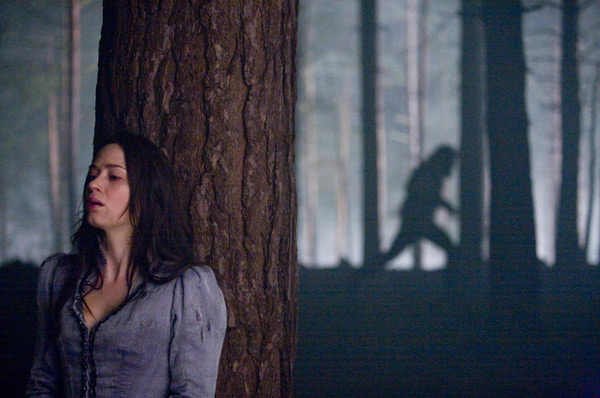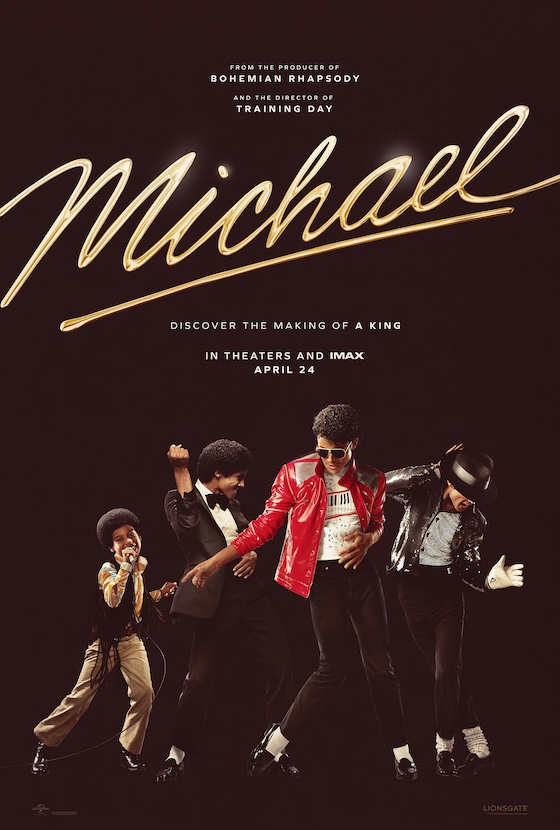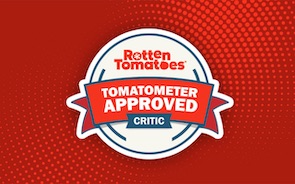
"The struggle of making a film for any studio is the fact that the producers and the studio have an idea of what the movie should be, but that is especially the case when the director is being replaced three weeks before principal photography. The challenge for me was to make sure that was my version of 'The Wolfman.' And I've done that...I think."
- Director Joe Johnston in an interview with the L.A. Times
While this prolonged season of cold - full of icy chills - still holds a tight and frigid grip over most of America this year, it seems certainly appropriate to embrace the gothic nature of winter with a really good classic monster film and bury our heads under the warm covers of safety when moments get too intense. It's almost as if Universal knew this and that's their reasoning for the delay of The Wolfman - almost. Full of moments that showcase the film's intended campy nature and its gnarly teeth, director Joe Johnston's steady hand and fine knowledge of classic film gusto can only go so far with a film that, in its present state, suffers from a severe case of identity crisis.
Boasting to be no more than what it is: a remake of 1941's production (written by Curt Siodmak), The Wolfman is the tale of stage-actor Lawrence Talbot's (Benicio del Toro) reconciliation with his father, Sir John Talbot (Anthony Hopkins) after the sudden disappearance of his brother from their home in Blackmoor. Prompted by a beseeching letter written by his brother's grieving ex (Emily Blunt), the estranged Talbot returns home only to discover his brother has been recently murdered by a strange beast in the shadowy forest. Believed by the villagers and local law enforcement to be the work of a dancing bear belonging to some forest-dwelling gypsies, Talbot sets out on a dark and spooky night to find this group and confront them with his knowledge of their animal's wild nature. A sudden attack on the gypsies by something wolf-like and howling results in an infectious bite that leaves Talbot hurting and... well... everyone knows what happens if one should survive the bite from a werewolf; there's a brand new side of Talbot that wants to break free, kill some people and... howl at the moon, but not if Scotland Yard's Aberline (Hugo Weaving) has anything to say about it.{googleads}
Originally slated to be released in November of 2008, The Wolfman has been, to put it mildly, in developmental hell since its production announcement back in spring of 2006. From a significant and startling switch in its directors, a change in its score, to severe disagreements over the special effects, the troubling reshoots, and then all the different cuts of the film, one can safely say that The Wolfman has been in a constant state of transformation for 4 years. That's one hell of a full moon. That being said, well-wishers of the franchise and fans of the classic Universal Monster films have plenty to howl with pleasure at and applaud under Johnston's solid direction, but it's not quite enough to save the film from the source of its biggest fault: the first twenty minutes.
Choppy, hackneyed, and severely unfocused, the narrative's opening is much too hurried of an event for those that don't suffer from ADHD and almost grinds Johnston's film to a complete halt for a lack of steady structure. The story needs to establish a foundation before swirling around with modern, interruptive cuts as it quickly heads to Talbot's fate in the forest. The harsh editing and fast-to-slow-to-fast-to-slow pacing issues recalling the quick-cutting issues Kenneth Branagh's much-maligned remake of Frankenstein had (even though it gets high marks from me for being consistent) suggests that, at one time, there existed a director's cut of the film that had a more thoughtful approach to its beginning where important plot points are revealed, characters are developed, and where the dialogue is served better. With four different editors taking turns at The Wolfman's old chopping block; however, one can see how its overall sense of identity could get unevenly bludgeoned and butchered.
Johnston's movie does settle down and allows the middle part of the movie to shine, though. It becomes fun and campy healthily balanced with a severe helping of violence and camera-inducing shocks. Upon Talbot's first full moon after being bitten, the audience aided by Rick Baker's incredible make-up effects (that, thankfully, keep and highlight Jack Pierce's original 1941 design) sees the real appeal of The Wolfman: bone-crunching, shape-changing, four-legged transformation. Toro's change into the werewolf is intense, carnal, and fully realized and it should be; $85 million will do wonders for B movie material, folks. Baker's make-up work is a serious article for discussion in the horror business and it's incredibly able-bodied in this film both fierce and feral visually revealing the extreme nature and the violence of lycanthropy. When it comes to its characters; however, The Wolfman barks more that it bites; it's full of quality actors that have little to do. While, due to the nature of the film, the actors don't need to be anything more than B movie players, it would have been nice to see some development from its story; what you have instead is a constant, unchanged character from beginning to end. Toro, with his wrinkled James Dean-esque brow, has always resembled a werewolf and as a self-admitted fan of previous Wolf Man features draws upon earlier incarnations of the beast rather productively. Recalling the character acting of Lon Chaney, Jr and Henry Hull, Toro is coolly watchable and, when let loose as the shaggy fiend on its full-moon prowl, a lot of fun to cheer on. Unfortunately, there is little in the script (besides an escape from a madhouse) for poor Talbot to do but brood about until the next transformation so, as a result, little sympathy is garnered for his character. The same can be said of Emily Blunt's all too brief appearance in the film. Beyond being semi-nude in a weird hallucinogenic dream of Talbot's, there is not much - apart from what is clearly stated and restated by the gypsies - for her to do. Her part is so poorly undeveloped by choice edits that the significance of the ending plays out only upon the heartstrings of the gullible.
When it comes to its characters; however, The Wolfman barks more that it bites; it's full of quality actors that have little to do. While, due to the nature of the film, the actors don't need to be anything more than B movie players, it would have been nice to see some development from its story; what you have instead is a constant, unchanged character from beginning to end. Toro, with his wrinkled James Dean-esque brow, has always resembled a werewolf and as a self-admitted fan of previous Wolf Man features draws upon earlier incarnations of the beast rather productively. Recalling the character acting of Lon Chaney, Jr and Henry Hull, Toro is coolly watchable and, when let loose as the shaggy fiend on its full-moon prowl, a lot of fun to cheer on. Unfortunately, there is little in the script (besides an escape from a madhouse) for poor Talbot to do but brood about until the next transformation so, as a result, little sympathy is garnered for his character. The same can be said of Emily Blunt's all too brief appearance in the film. Beyond being semi-nude in a weird hallucinogenic dream of Talbot's, there is not much - apart from what is clearly stated and restated by the gypsies - for her to do. Her part is so poorly undeveloped by choice edits that the significance of the ending plays out only upon the heartstrings of the gullible.
Equally a victim of harsh studio edits, Hopkins' turn as Papa Talbot is momentously neutered; ironic because Johnston had to convince Hopkins to stay aboard promising that those scenes which were cut by the studio would be in the theatrical cut. Grossly wasted as a talent, Hopkins' role gets trimmed leaving too much to be inferred - making his gravitas and the film's showdown between father and son seem puny and not nearly as epic as it could have been. The saving grace of the film, as far as the acting is concerned, is Weaving's character of Francis Aberline, though even his seemingly multi-layered character is densely betrayed by the near-sighted construct of the narrative. While, even after the reshot ending, remaining only a minor character, Weaving is entirely gratifying throughout the film as the misunderstood representative of law and order - and is well-positioned for greater things should there be a sequel.
What works in the film, besides Johnston's direction, is the bleak and ghostly pale landscape as captured by cinematographer Shelly Johnson. Shot in the United Kingdom, the locale specifically tinted gray and colorless adds a tonal quality to the gothic nature of the tale and - because the script certainly doesn't - provides the isolating impression of the supernatural events. Also working to full effect are the buckets of gore and bone thrown at the audience courtesy of the werewolf attacks. This is Johnston's first R-rated film and it beheadings and all wears that stamp of adult material proudly. Danny Elfman's once-deleted score also adds to the overall moody effect of the film; it is some of his best darkly rich material calling into question what the studio â"suits" were thinking by, at one time, axing the score entirely in favor of a blip-and-bleep all-electronic programmed atmosphere.
As a fan of Joe Johnston's previous efforts and taking into account the production's ill-fated history*, one can hardly lay the blame at his feet for the film's shortcomings and please note that The Wolfman is far from being the dud as some have dismissively predicted; it's entertaining when it lets loose and finds its footing and certainly has its fair share of hair-raising moments despite its problem areas. Even if it doesn't live up to the titular legacy or the previous standards of its director's recent successes, given all the unreasonable refuse that has happened to the production of The Wolfman, every audience member should recognize - and be thankful for - the steady hands that made this film rise above the massive train wreck that it easily could have been.
*(Be on the lookout for the director's cut.)
Blu-ray Details:
Available on Blu-ray and DVD - June 1, 2010
Screen Formats: 1.85:1
Subtitles: English SDH, French, Spanish:
Audio: English: DTS-HD Master Audio 5.1; French: Dolby Digital 5.1; Spanish: Dolby Digital 5.1
The Director’s Cut added what it promised: more depth, more structure, more myth, and more mystery and all in the film’s beginning; it certainly improves the overall atmospheric quality of the theatrical version and – in my estimation – certainly adds another reel to this experience. If you stumbled your way through the clunkiness of the theatrical version’s off-kilter beginning, Joe Johnston’s unrated version will fill your gut with warm fuzzies and a little Max Von Sydow. Wait! Max Von Sydow was in this and it was cut? Indeed. A key sequence that explains that fancy cane Lawrence carries was axed in order to get to the transformation scene faster. Never no more, though! We get mystery, extended chase sequences, backstory (what a concept), and more gothic guts with the unrated version. Very nicely done. You also get a digital copy of the film, and the disc is equipped with BD-Live and is D-Box Enabled. As a bonus, you can also stream the 1941 film for a limited time via BD-Live.
U-Control (only available on the theatrical version): Members of the crew appear as you watch the film with in-depth info on how the movie was filmed (sometimes they'll stop the movie or show a scene in slow-motion). The option to watch the movie in "Legacy, Legend and Lore" mode exists and this offers trivia and video footage via pop-ups that explore the history of werewolves and the original movie.
Featurettes:
- Return of The Wolfman (12 minutes): A standard featurette offering interviews with the cast and crew about the film. There are some interesting moments from Hopkins on the psychological elements of the movie which the Director’s Cut rectifies.
- The Beast Maker (12 minutes): A featurette on Rick Baker. Nuff said.
- Transformation Secrets (15 minutes): Since we had a featurette on the physical effects, this one offers some insight on the digital effects in the film - which are less interesting than Baker's make-up effects.
- The Wolfman Unleashed (9 minutes): The live-action sequences in the film are highlighted, suggesting there was even less CGI than previously assumed by some critics.
Alternate Endings (8 minutes): Two alternate endings, one of tragedy (more so than the original ending), and the other just plain silly setting the stage for a sequel.
Deleted and Extended Scenes (11 minutes): Deleted/extended scenes that are not featured in the unrated edition. Some are quite nice and puzzling as to why they aren’t included in the extended cut.
{pgomakase}





























